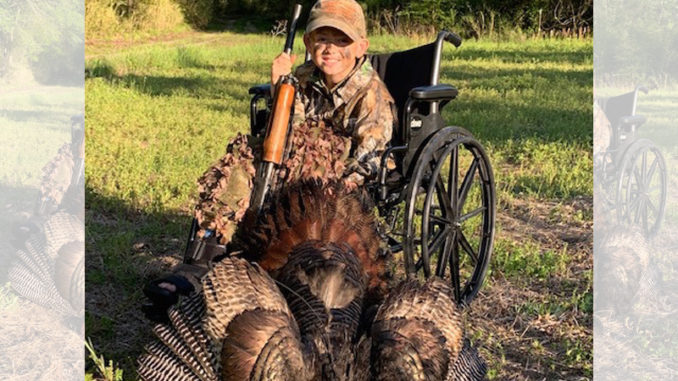
Gobbler was wearing leg band and tracking collar
On Wednesday, April 15, 2020, Jesse Bunn was hunting from a wheelchair when he shot a gobbler wearing a leg band and a tracking collar. His grandfather, Johnnie Dale, and mother, Rebecca Bunn, were pushing. Jesse is a 9-year-old third-grader at Neuse Charter School who lives in Selma.
“I jumped off a 10-foot high dirt pile and broke my foot,” Jesse said. “They put a boot on it that won’t come off for two months.”
Johnnie Dale operates Buffalo Creek Guide Service (919-915-0193). They were hunting in the afternoon from a Kubota UTV.
“We got onto the Kubota and Papa slammed on brakes when he saw two big toms,” Jesse said. “We moved and called three different times. The last spot had a big fire ant hill and we had to move off the path. When one tom stuck his head up, I shot and he fell into the ditch and got all wet.”
“We unloaded the wheelchair and pushed it along a trail with a ditch and a hedgerow,” Johnnie said. “The distance was long for a 20-gauge Remington 870 youth model with Federal turkey loads. When the gobbler flopped in the ditch, the other tom came running back and gave Rebecca her chance.”
“At the end, it was tough,” Rebecca said. “We stopped pushing the wheelchair at the fire ant hill. I missed the other tom. I got one the next day, though.”
Radio-collared was part NCSU study
Johnnie put Jesse’s gobbler in a walk-in cooler and called WRC Enforcement Officer Matthew Parrish the next day. Parrish gave him the phone number of NCSU Graduate Student David J. Moscicki.
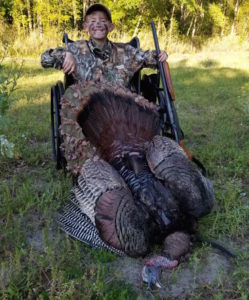
“We are working with the NCSU North Carolina Wild Turkey Ecology Study,” Moscicki said. “It’s a collaborative project between NCSU, NWTF and WRC. We captured 50 hens and 30 gobblers in each region – coast, piedmont and mountains. Hens have GPS tracking collars with batteries that last two years and show movement patterns. They tell us when they nest and how successful they are. Males have VHF collars with batteries that last five years and tell if they are alive or dead.”
Moscicki said turkey populations are trending downward throughout the southeast and the study may reveal the causes. This is the first year of the three-year study.
“The technicians were only two miles away, so they came by,” Johnnie said. “They checked the collar that morning and it showed the tom was alive, but he was dead in the cooler. We kept the band, but they took the harness.”
“Jesse wants to mount the tom strutting so he can see it gobbling every morning when he wakes up,” Rebecca said. “We will make a replica of the collar. It was held on with two small Bungee cords.”
Anyone who shoots or finds a turkey wearing a telemetry collar should call the telephone number on the leg band or send an email to the address on the collar.

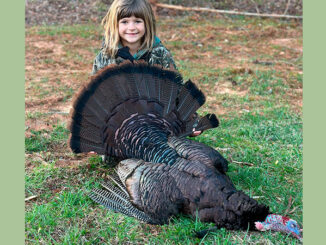
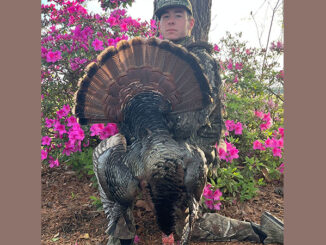
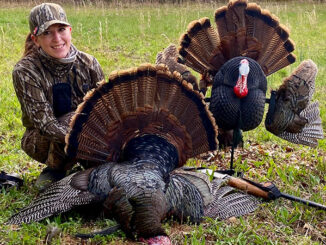

Be the first to comment